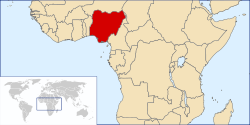Difference between revisions of "Yoruba identity in Nigeria"
| (9 intermediate revisions by the same user not shown) | |||
| Line 1: | Line 1: | ||
| − | Colonial formation of local ethnicity: the case of the Yoruba | + | '''Colonial formation of local ethnicity: the case of the Yoruba in Nigeria''' |
| + | [[Image:250px-LocationNigeria.svg.png]] | ||
| − | + | ---- | |
| + | ''Some observations:'' | ||
| − | + | * Pattern: social internalization of external social grouping imposed by more powerful culture, absorbed as a hegemonic internalized structure. | |
| − | |||
| − | |||
| − | |||
| − | |||
| − | + | * Constructions of ethnicity, implying a degree of homogeneity, often result from an outsider perspective, since the "homogeneity" of an "ethnic group" is only "visible" from the outside. | |
| − | + | ||
| − | + | * When the "outside" is powerful (i.e. colonialism, imperialism), the outside--vested in special interests--becomes the hegemonic insider perspective, though not without resistance. | |
| − | + | ||
| − | + | * Such homogenization is a useful tool for governance, colonial or otherwise, and its use often occurs within positions of power. | |
| − | + | ||
| − | + | * Thus the operation of "othering", when carried out from a position of superior power, may become a primary source of identity. Yet such identities, once internalized, can also be revised to serve new ends, e.g. transformed into a tool of colonial resistance. | |
| − | + | ||
| − | + | ---- | |
| + | |||
| + | |||
| + | [[Formation of Yoruba identity]] | ||
| + | |||
| + | [[Yoruba neo-traditional popular music]] | ||
| + | |||
| + | [[The role of neo-traditional Yoruba music]] | ||
Latest revision as of 15:04, 25 September 2007
Colonial formation of local ethnicity: the case of the Yoruba in Nigeria
Some observations:
- Pattern: social internalization of external social grouping imposed by more powerful culture, absorbed as a hegemonic internalized structure.
- Constructions of ethnicity, implying a degree of homogeneity, often result from an outsider perspective, since the "homogeneity" of an "ethnic group" is only "visible" from the outside.
- When the "outside" is powerful (i.e. colonialism, imperialism), the outside--vested in special interests--becomes the hegemonic insider perspective, though not without resistance.
- Such homogenization is a useful tool for governance, colonial or otherwise, and its use often occurs within positions of power.
- Thus the operation of "othering", when carried out from a position of superior power, may become a primary source of identity. Yet such identities, once internalized, can also be revised to serve new ends, e.g. transformed into a tool of colonial resistance.
